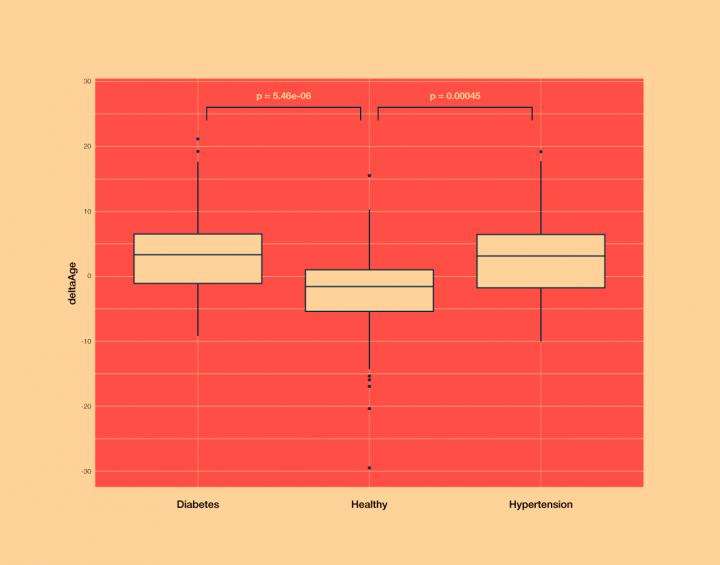Carotid artery analysis reveals human biological age

Biological age, as opposed to chronological age, is a concept used to describe the state of an organism. An average healthy individual's biological generally corresponds to their chronological age. But with age, these two indicators are likely to become mismatched due to environmental factors, bad habits, manifestations of hereditary diseases, and other causes. So far, there is no established method of predicting biological age. Medical and scientific researchers are looking for a marker that could accurately and consistently reflect biological age.
A new study by researchers at the Moscow Institute of Physics and Technology, based on a combination of carotid ultrasound and tonometry data, proposes a new measure of biological age. Using machine learning, the researchers developed a model capable of determining the biological age of healthy men and women with a mean absolute error of 6.9 and 5.9 years, respectively. The test set also included subjects with hypertension and type 2 diabetes, whose biological age turned out to be, on average, three years greater than their actual age.
"Researchers have been trying to find a means to estimate human biological age for decades. The most accurate of the existing techniques are based on DNA analysis (the so-called epigenetic clock) and can predict human age with a median error of three years. However, these tests require expensive equipment and skilled laboratory personnel, which is the reason why they are still not widely used in medical practice. Our method relies on a type of patient-related data any modern health care facility can obtain," says Alexey Moskalev, who heads the Laboratory of the Genetics of Aging and Longevity at MIPT's Center for Living Systems.
In their study, the authors relied on information about the cardiovascular system—specifically, the minimum middle layer thickness of the carotid artery tissue, the pulse wave velocity, carotid artery diameter (the degree of stenosis), and the augmentation index (the difference between the second and first pressure peaks in a pulse wave). Individually, all of these are established markers used for diagnosing atherosclerosis, hypertension, calcinosis, diabetes, and other conditions. The researchers chose these stats after performing a correlation analysis, a technique used to measure the association between variables.
The main result of the study is that a model has been developed in which biological age is derived from these four clinical parameters. Coefficients for each of the parameters were calculated using machine learning, namely robust regression. For this study, a total of 303 subjects (199 women and 104 men) were selected, their age varied from 23 to 91. All of them had visited the National Research Center for Preventive Medicine in Moscow, Russia, back in 2012. Robust regression analysis provides an alternative to the least squares method. It is essentially an attempt to approximate the observed dependence using a formula.
In other words, the method seeks to pick the variables in a formula so as to make sure the resulting curve fits experimental data. There are, however, certain fundamental differences between the two alternatives that make robust regression preferable. Machine learning methods have long been used to evaluate biological age. Recent years have seen a rise in popularity of deep neural networks, which enable researchers to build high-accuracy models. And yet their application is not always justifiable, as they, among other things, require a large number of tests and parameters, which is not always feasible in clinical practice.
Alexander Fedintsev, a bioinformatics specialist from the Engelhardt Institute of Molecular Biology of RAS, the first author of the article, says, "We used nonlinear robust regression, since it does not rely on a priori assumptions of the distribution of the dependent variable and therefore is robust to outliers. Since the number of factors is limited, the model can be taught using a relatively small amount of data. In addition to being fairly accurate, it also provides an easy interpretation of the results—we can tell for sure how the predicted age will change if the measured parameters are varied. It is worth noting, though, that qualitative data was at the heart of this research. Thanks to a large database with a variety of biomarkers, we managed to select the most important factors, which helped us maintain a low error rate while predicting age despite the fact that we were using a rather simple and compact model."
To test the validity of the new method, the researchers compared their biological age estimates with the data obtained through other techniques for evaluating the state of an organism. Correlation of predicted biological age with Framingham CVD Prediction Scores—an algorithm that estimates a patient's risk of developing cardiovascular disease and is not based on carotid ultrasound imaging—exceeded that of chronological age. Also, the method was compared with other data processing techniques. The findings were contrasted with those obtained using the Klemera-Doubal statistical method. Again, correlation with biological age exceeded that of chronological age.
Olga Tkacheva, director of Russian Clinical Research Center for Gerontology, who co-authored the article, says, "Since we used the cardiovascular system as our only source of information, additional research considering other factors is necessary to refine biological age estimates. However, recent research has shown that the relationship between the state of blood vessels and biological age appears to be even stronger than between the state of blood vessels and chemical composition of blood."
According to WHO statistics, heart disease is the leading age-related cause of death, so it seems only natural to claim that the technique developed by the researchers is an effective means of determining biological age.
More information: Alexander Fedintsev et al, Markers of arterial health could serve as accurate non-invasive predictors of human biological and chronological age, Aging (2017). DOI: 10.18632/aging.101227




















